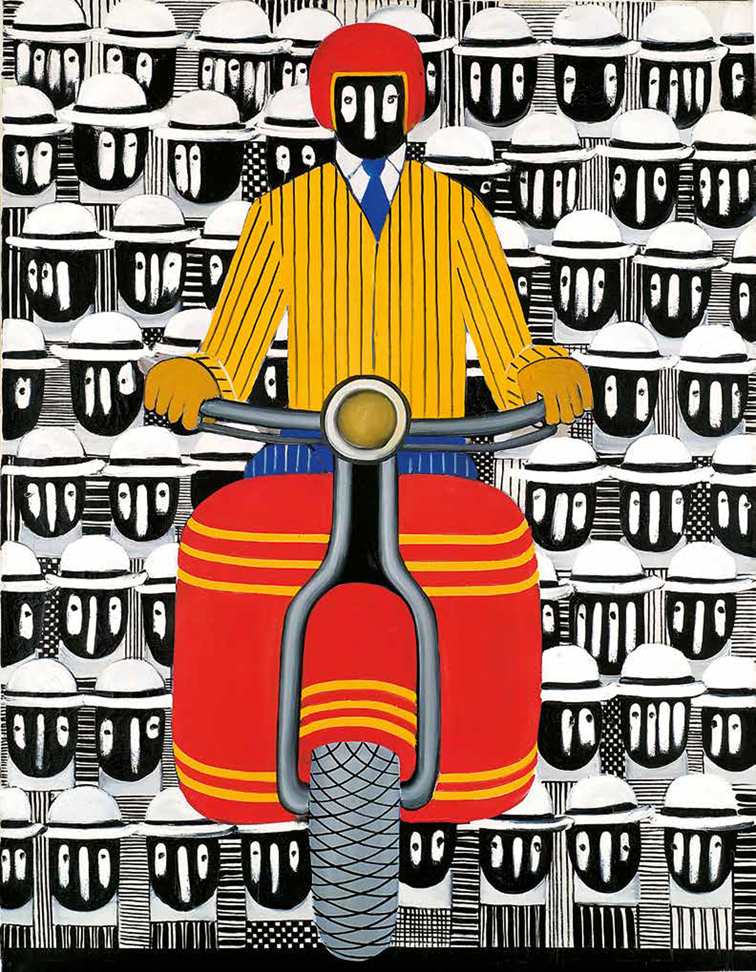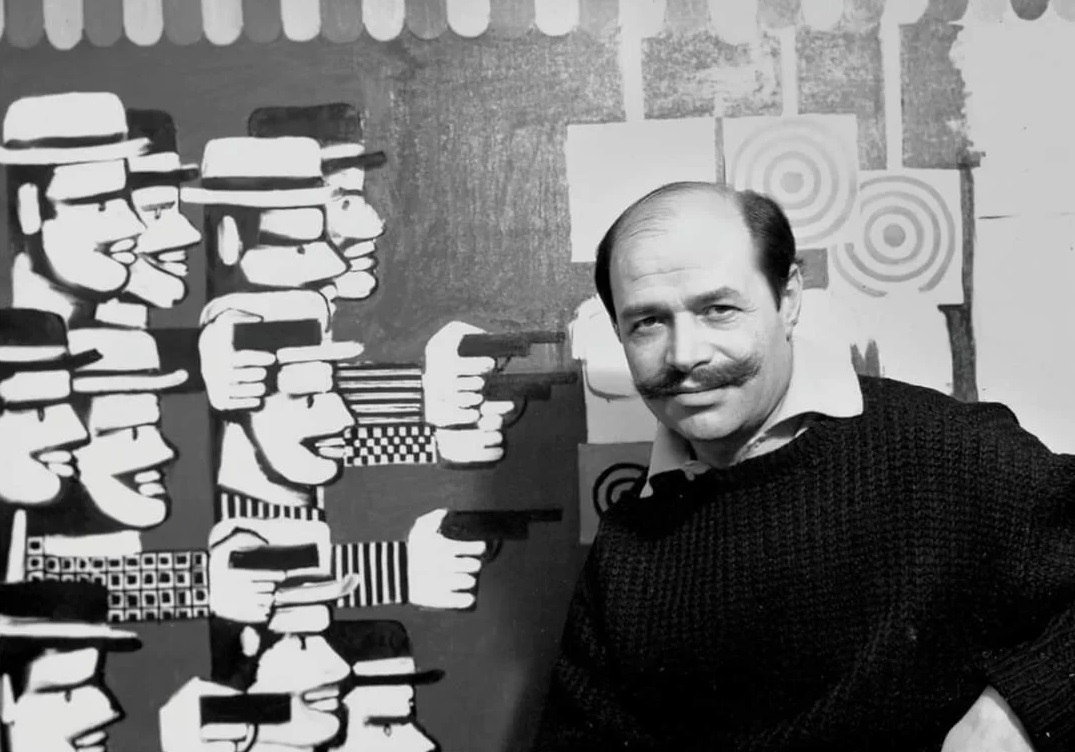
The first Human by Giannis Gaitis appeared around 1967, shortly before the April 21st military coup. The little man is neither cute nor cheerful. He is a mannequin that carries our nerves, who sometimes has four eyes and sometimes three noses, he is watching and many others like him are watching him – sarcastic figures, disturbing figures. Is the Little Man laughing at us or scaring us? The artist himself said: “People don’t want to see themselves as Little Man.” That is, he prefers a pebble, a flower or something else, but not the Little Man! Because, he tells you, I am not him. But this!”.
But the Little Man came into his life to stay. This artist, who grew up in Athens in the 1940s in the post-war years with great social and economic difficulties, studied painting at ASKT under the teacher Parthenis, found in Antrumaki the absolute hero of his visual universe. And it happened not in Athens, but in Paris, where Gaitis came with a scholarship to study. In Paris, where Konstantinos Parthenis, Spyros Papaloukas, Fotis Kontoglu had previously passed. In Paris, where Greek-born publisher Christian Zervos, with the long-lived modernist magazine Cahiers d’Art, reintroduced ancient Greek art to modern Europe, while Stratis Eleftheriadis-Theriades, an art critic and collector from Mitylene, published the surrealist magazine Minotaure.
In this city, which found itself in the 1950s at the center of expressive searches that formed the avant-garde in European art, many Greeks of the artistic generation of the 60s settled. Their role in Paris was important as Dimitris Tsygos, Gerasimos Sklavos, Takis, John Christoforou, Yiannis Tsarouchis, Alekos Fasianos, Pavlos, Kostas Tsoklis, Nikos Kessanlis, Vlasis Kaniaris, Yiannis Maltezos, Daniel gave a different impetus to modern Greek art. They also collaborated constructively with museums, art galleries, galleries, international artists, prominent theorists and art historians, reinforcing the new image of Greek visual reality abroad.
Among them was Yannis Gaitis. He ended up there, like them, without acquaintances, with financial problems, but he was, like them, young, enthusiastic and ready to live a truly creative time. At the age of 31, he settled in the French capital, where he lived for two decades. Next to him stood the sculptor Gabriella Simosi. They married the year they arrived in the city, in 1954, and their only daughter, Loretta, was born.

“People don’t want to see themselves as Little People. He prefers a pebble, a flower, or something else, but not the Little Man! Because, he tells you, I am not him. But this!”.
Kostas Tsoklis confessed to critic and curator Takis Mavrotas: “I was very good friends with Giannis. For many years, Gaitis looked closely at other people’s work, but he eventually managed to get a very personal work that no one else has. In this he is to be commended. Attractive. His People are his very personal work, unlike Gabriella, who was an introvert and looked not at what others were doing, but at herself. He was out of his heart, he wanted happiness and life. Gabriella’s art expresses an inner work that is not identified with her time. They were an odd couple. One is an extrovert, one is an introvert, one is lucky, the other is unlucky. I knew him from the School of Fine Arts, although he was older than me. He always wanted to do modern things. They went to Paris with a scholarship. The spiritual father of both was Tsigos, a great man, an architect… In Paris we saw each other almost every day, I had a small workshop in the Cité des Arts, and he lived on the rue de Sèvres. Every morning I drove past his studio to drink coffee and play with a motorcycle … “.
In 1959, Gaitis actively participated, together with Caniaris, Tsoklis, Kondo and Kessanlis (Group Sigma), in two exhibitions at the Galleries Cancello in Bologna and San Carlo in Naples, presenting his work as a group. 1964 was the year of the historical exhibition “Mythologies Quotidiennes”. Among the 37 European artists who took part were “new realists” such as Saint-Fals and Voss, theorists and subversives such as Pistoletto, and teachers such as Cremonini who commented on political and social reality with humour, provocation and courage. of that time, there was also Gaitis. He presented works that were clearly influenced by ancient Greek art and mythology.
Speaking again with Takis Mavrotas, Leonardo Cremonini confessed about his last retrospective exhibition in Athens, which he curated in 2010: “I believe that the message of a work of art can only be revealed to those who seek it. Ancient Greek art had a decisive influence on my painting. The incentives I experienced in my youth when I visited Pompeii were great. Ancient Greek sculpture helped me form my own art. I was influenced by all the monuments of ancient Greece because they are centers of knowledge and learning. Nowadays, unfortunately, there are no corresponding monuments. Ancient Greek art has left us eternal examples of inspiration and knowledge.”

Exhibition “Janis Gaitis. The Essence of the Faceless opens next Wednesday at the Tchaikovsky Foundation for Visual Arts and Music. V. and M. Theocharakis on the occasion of the 100th anniversary of the artist’s birth, in collaboration with his daughter Loretta Gaitis and curated by Takis Mavrotas. The exposition includes about 100 works, covering the path of his creative path, from the famous “Self-portrait” of 1944 to the end of his creative activity. It begins with the artist’s self-portraits, portraits of his family and his wife, the sculptor Gabriela Simosi, and her work in plaster, polyester and brass is displayed alongside her enigmatic collages. The exhibits come from the National Gallery, public collections of institutions, large and small private collections. The presentation will be accompanied by a multi-page catalog of the same name with all the exhibited works. Mr. Mavrotas’ introductory text provided “K” with valuable material for writing the article.
Source: Kathimerini
Ashley Bailey is a talented author and journalist known for her writing on trending topics. Currently working at 247 news reel, she brings readers fresh perspectives on current issues. With her well-researched and thought-provoking articles, she captures the zeitgeist and stays ahead of the latest trends. Ashley’s writing is a must-read for anyone interested in staying up-to-date with the latest developments.